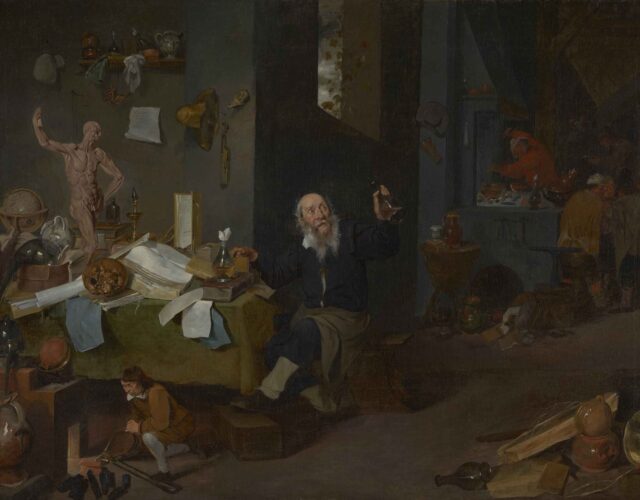Part of what artists do is transform things: they turn plain canvas, oil, and pigment into illusionistic masterpieces. The 17th-century Dutch art theorist and painter Samuel van Hoogstraten stated that a good painting was like a “mirror of nature” that could reflect reality back to the viewer in a more perfect form.
Mimicking and perfecting nature—and uncovering its secret workings—was also the goal of many alchemists. Alchemists studied matter, tested its properties, and combined materials in experimental forms. In a sense this search for natural knowledge made artists and alchemists ideal collaborators. Artists studied human anatomy in order to skillfully replicate it, while alchemists investigated human physiology to diagnose and treat illness. Artists tried to capture fleeting or ephemeral natural phenomena—clouds, smoke, and reflected light—while alchemists tried to control changes in matter through such processes as sublimation, watching solids vaporize under intense heat.
Some artists, especially those whose techniques were considered “experimental,” embraced alchemy as a partner in their work. The 16th-century Flemish master Jan van Eyck pioneered painting with oils through his experiments in distillation, and the 17th-century Dutch painter and engraver Hendrick Goltzius hired an alchemist to live in his workshop and teach him to manipulate gold and silver. Other artists recognized the relationship between alchemy and art but saw alchemy as a rival rather than as a partner. The Florentine genius Leonardo da Vinci derided alchemists as frauds who could not replicate “the slightest thing” that nature itself produced, while arguing that artists’ imitations of nature were more convincing. But despite his harsh words even Leonardo tried his hand at a few alchemical experiments.
The merging of artistic and alchemical thinking is evident in The Alchemist by 17th-century Flemish artist Mattheus van Helmont. At center the alchemist raises a glass vial to peer closely at the liquid within. This gesture may indicate he’s engaged in urinoscopy, an analysis of a patient’s urine, to diagnose an illness that could be treated with chemical remedies. At left, his (much smaller) assistant stokes a fire in a small furnace, puffing air with a pair of hand bellows. Both activities are common in alchemical scenes, but other details in the room indicate this alchemist’s engagement with art, music, and creative thought. On the table we see an écorché (literally, “flayed”) figure, a type of plaster sculpture often used by artists to learn the placement of muscle groups hidden beneath the skin. On the wall hangs a violin, which is sometimes shown in images of painters’ studios to symbolize inspiration and the imaginative impulse. Van Helmont’s choice to depict books, globes, glassware, musical instruments, sculpture, and laboratory tools mixed together in the alchemist’s workspace is not coincidental or haphazard. Instead, it shows the painter’s sophisticated understanding of how alchemy and art could affect and inspire each other.
Today we see art studios and laboratories as completely separate, even opposing, spaces. But in the early modern world art and chemistry were intertwined. Both were believed to have much to teach us about nature—and our place in it.




